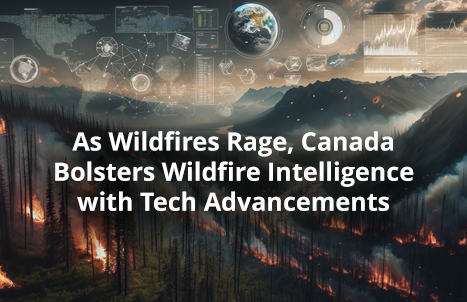

As Canada heads into another wildfire season, the Canadian Safety and Security Program (CSSP) has announced a call for proposals to advance wildfire detection and suppression through innovative science and technology solutions.
A key goal of this initiative, called ‘S&T challenge: Wildfire firefighting ‘common operating picture’, is to enhance the efficient use of wildfire information, including satellite-based Earth Observation data, propagation modelling forecasts, and resource availability. Currently, wildfire intelligence often arrives piecemeal, using various tools and software, which can lead to confusion and suboptimal operations. The CSSP seeks to address this by developing integrated solutions that provide clear, cohesive, and actionable intelligence to wildfire-fighting teams.
Key Objectives of the Wildfire Intelligence Challenge:
- Developing a Common Operating Picture (CoP): This initiative aims to create an integrated and cohesive operational view for wildfire fighting operations. By streamlining and consolidating data, the CoP will enhance the capabilities that support incident commanders and frontline wildfire fighters, enabling more efficient and effective decision-making during wildfire incidents.
- Creating a Wildfire Synthetic Environment (W-SE): This involves developing a simulated environment for concept development, experimentation, and training of Incident Management Team (IMT) commanders. The W-SE will facilitate the execution of wildfire “war games,” similar to the simulation exercises conducted by the Department of National Defence/Canadian Armed Forces (DND/CAF), to improve preparedness and strategic response to wildfire threats.
The initiative is part of the CSSP’s broader mission to bolster public safety and security in Canada through the strategic application of advanced technologies.
Canadian Space Agency’s Plan for WildFireSat
Last year, the Canadian Space Agency announced plans to launch the world’s first dedicated public fire-monitoring satellite into orbit. Currently, Canada relies on several satellites for fire data, including key instruments aboard the European Space Agency’s Sentinel satellites, infrared sensors on several satellites owned by the U.S. National Oceanic and Atmospheric Administration (NOAA), and high-resolution photographs from Moderate Resolution Imaging Spectroradiometers (MODIS) on NASA’s Aqua and Terra satellites.
However, there is currently a gap of several hours when no satellite images are available. This blackout period coincides with the most critical time for wildfire activity—the late afternoon “peak burn period.”

The $170-million WildFireSat mission, planned for launch in 2029, aims to address this crucial gap by capturing measurements during this critical peak burn period. Moreover, the WildFireSat mission will integrate data collected by the WildFireSat satellites with publicly accessible data from current satellite systems.
The WildFireSat mission – a joint initiative of the CSA, the CFS and the Canadian Centre for Mapping and Earth Observation (CCMEO), both part of Natural Resources Canada (NRCan), and Environment and Climate Change Canada (ECCC) – will monitor all active wildfires in Canada daily, providing reliable data to predict fire behavior better, help wildfire managers prepare and respond, and enable more targeted and faster evacuations. It will also offer precise information on smoke, air quality conditions, and the carbon emitted by wildfires, thus protecting lives, health, resources, infrastructure, and the environment.
Canada’s Billion Dollar Annual Wildfire Expenditure
After the record-breaking wildfire season of 2023, parts of Canada are already contending with severe fires or are on high alert. The federal and provincial governments are adopting a new approach to wildfire management. The strategy, known as the Canadian Wildland Fire Prevention and Mitigation Strategy, aims to build new and strengthen existing partnerships between levels of government.
The 2023 fire season was unprecedented, with approximately 15 million hectares burned – about seven times the annual average. Unfortunately, such extreme fire seasons are expected to become more common, with the amount of forest burned by wildfires projected to double by 2050 as climate change brings in longer wildfire seasons, more extreme weather conditions, and increased droughts.
Canada spends about $1 billion annually fighting wildfires, and the cost for the 2023 season is expected to be more than double that amount. However, the indirect costs of wildfires may rise to several billion dollars per year when considering property loss, damaged infrastructure, industrial shutdowns, evacuations, health-related expenses, and economic losses in various sectors, including tourism, forestry, and energy.
The 2023 wildfire season in Canada was so devastating that it alone contributed to a 24% increase in global tree cover loss outside of the tropics, despite significant gains made by Brazil and Colombia. According to data released in April by the World Resources Institute, Canada accounted for more than half of the world’s forest loss due to fire last year. Remarkably, 92 percent of the forest lost in Canada, including all forests not just those outside the tropics, was due to wildfire.





Be the first to comment